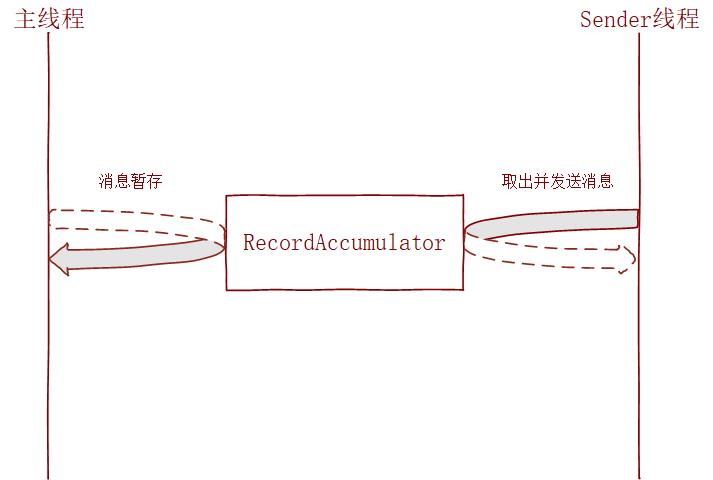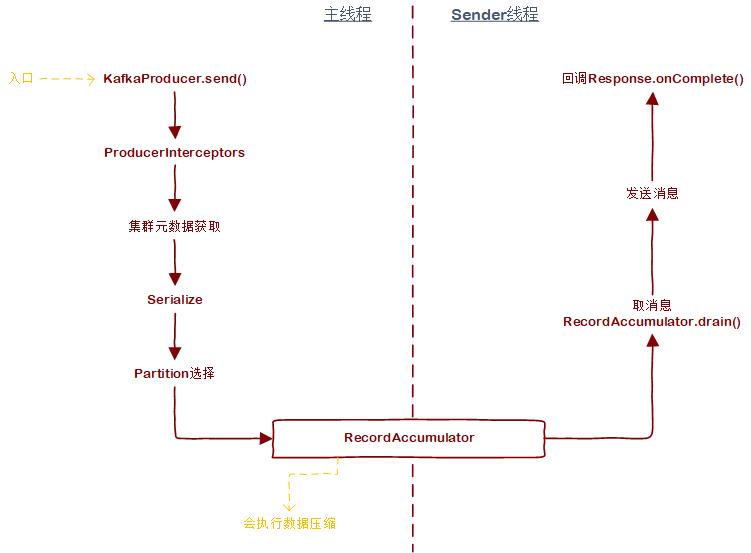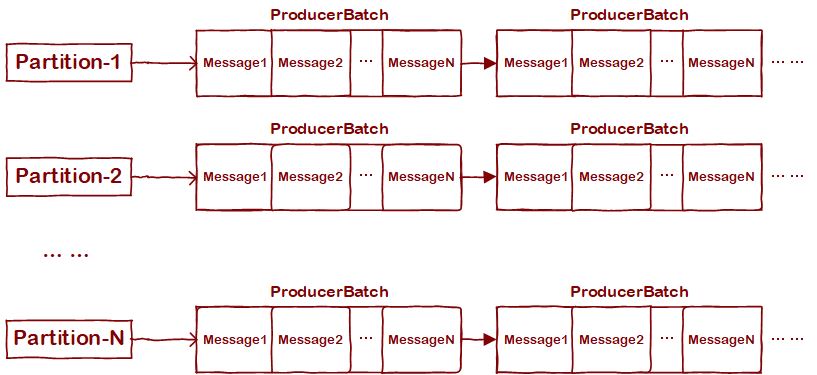系列文章目录
https://zhuanlan.zhihu.com/p/367683572
目录- 系列文章目录
- 一. 使用方式
- step 1: 设置必要参数
- step 2: 创建KafkaProducer
- step 3:构造要发送的消息
- step 4:发送消息
- 二. 线程模型
- 三. 源码分析
- 1. 主线程
- 1.1 KafkaProducer属性分析
- 1.2 ProducerInterceptors
- 1.3 元数据获取
- 1.4 Serialize
- 1.5 Partition选择
- 2. RecordAccumulator
- 3. Sender线程
- 3.1 NetworkClient
- 3.2 Sender线程业务逻辑
- 1. 主线程
- 四. 总结
一. 使用方式
show the code.
public class KafkaProducerDemo { public static void main(String[] args) { // step 1: 设置必要参数 Properties config = new Properties(); config.setProperty(ProducerConfig.BOOTSTRAP_SERVERS_CONFIG, "127.0.0.1:9092,127.0.0.1:9093"); config.setProperty(ProducerConfig.ACKS_CONFIG, "-1"); config.setProperty(ProducerConfig.RETRIES_CONFIG, "3"); // step 2: 创建KafkaProducer KafkaProducer<String, String> producer = new KafkaProducer<>(config); // step 3: 构造要发送的消息 String topic = "kafka-source-code-demo-topic"; String key = "demo-key"; String value = "村口老张头: This is a demo message."; ProducerRecord<String, String> record = new ProducerRecord<>(topic, key, value); // step 4: 发送消息 Future<RecordMetadata> future = producer.send(record); }}step 1: 设置必要参数
代码中涉及的几个配置:
- bootstrap.servers:指定Kafka集群节点列表(全部 or 部分均可),用于KafkaProducer初始获取Server端元数据(如完整节点列表、Partition分布等等);
- acks:指定服务端有多少个副本完成同步,才算该Producer发出的消息写入成功(后面讲副本的文章会深入分析,这里按下不表);
- retries:失败重试次数;
更多参数可以参考ProducerConfig类中的常量列表。
step 2: 创建KafkaProducer
KafkaProducer两个模板参数指定了消息的key和value的类型
step 3:构造要发送的消息
- 确定目标topic;
String topic = "kafka-source-code-demo-topic"; - 确定消息的key
key用来决定目标Partition,这个下文细聊。String key = "demo-key"; - 确定消息体
这是待发送的消息内容,传递业务数据。String value = "村口老张头: This is a demo message.";
step 4:发送消息
Future<RecordMetadata> future = producer.send(record);KafkaProducer中各类send方法均返回Future,并不会直接返回发送结果,其原因便是线程模型设计。
二. 线程模型

这里主要存在两个线程:主线程 和 Sender线程。主线程即调用KafkaProducer.send方法的线程。当send方法被调用时,消息并没有真正被发送,而是暂存到RecordAccumulator。Sender线程在满足一定条件后,会去RecordAccumulator中取消息并发送到Kafka Server端。
那么为啥不直接在主线程就把消息发送出去,非得搞个暂存呢?为了Kafka的目标之一——高吞吐。具体而言有两点好处:
- 可以将多条消息通过一个ProduceRequest批量发送出去;
- 提高数据压缩效率(一般压缩算法都是数据量越大越能接近预期的压缩效果);
三. 源码分析
先给个整体流程图,然后咱们再逐步分析。
1. 主线程
1.1 KafkaProducer属性分析
这里列出KafkaProducer的核心属性。至于全部属性说明,可参考我的"注释版Kafka源码":https://github.com/Hao1296/kafka
| 字段名 | 字段类型 | 说明 |
|---|---|---|
| clientId | String | 生产者唯一标识 |
| partitioner | Partitioner | 分区选择器 |
| metadata | Metadata | Kafka集群元数据 |
| accumulator | RecordAccumulator | 消息缓存器 |
| sender | Sender | Sender线程业务逻辑封装,继承Runnable |
| ioThread | Thread | Sender线程对应的线程对象 |
| interceptors | ProducerInterceptors | 消息拦截器,下文会说明 |
1.2 ProducerInterceptors
ProducerInterceptors,消息拦截器集合,维护了多个ProducerInterceptor对象。用于在消息发送前对消息做额外的业务操作。使用时可按如下方式设置:
Properties config = new Properties();// interceptor.classesconfig.setProperty(ProducerConfig.INTERCEPTOR_CLASSES_CONFIG, "com.kafka.demo.YourProducerInterceptor,com.kafka.demo.InterceptorImpl2");KafkaProducer<String, String> producer = new KafkaProducer<>(config);ProducerInterceptor本身是一个接口:
public interface ProducerInterceptor<K, V> extends Configurable { ProducerRecord<K, V> onSend(ProducerRecord<K, V> record); void onAcknowledgement(RecordMetadata metadata, Exception exception); void close();}其中,onAcknowledgement是得到Server端正确响应时的回调,后面再细说。onSend是消息在发送前的回调,可在这里做一些消息变更逻辑(如加减字段等)。输入原始消息,输出变更后的消息。KafkaProducer的send方法第一步就是执行ProducerInterceptor:
@Overridepublic Future<RecordMetadata> send(ProducerRecord<K, V> record, Callback callback) { // intercept the record, which can be potentially modified; // this method does not throw exceptions // 关注这里 ProducerRecord<K, V> interceptedRecord = this.interceptors.onSend(record); return doSend(interceptedRecord, callback);}// 该send方法重载核心逻辑仍是上面的send方法@Overridepublic Future<RecordMetadata> send(ProducerRecord<K, V> record) { return send(record, null);}1.3 元数据获取
接上文,ProducerInterceptors执行完毕后会直接调用doSend方法执行发送相关的逻辑。到这为止有个问题,我们并不知道目标Topic下有几个Partition,分别分布在哪些Broker上;故,我们也不知道消息该发给谁。所以,doSend方法第一步就是搞清楚消息集群结构,即获取集群元数据:
private Future<RecordMetadata> doSend(ProducerRecord<K, V> record, Callback callback) { TopicPartition tp = null; try { throwIfProducerClosed(); ClusterAndWaitTime clusterAndWaitTime; try { // 获取集群元数据 clusterAndWaitTime = waitOnMetadata(record.topic(), record.partition(), maxBlockTimeMs); } catch (KafkaException e) { if (metadata.isClosed()) throw new KafkaException("Producer closed while send in progress", e); throw e; } ... ... }waiteOnMetadata方法内部大体分为2步:
private ClusterAndWaitTime waitOnMetadata(String topic, Integer partition, long maxWaitMs) throws InterruptedException { // 第1步, 判断是否已经有了对应topic&partition的元数据 Cluster cluster = metadata.fetch(); Integer partitionsCount = cluster.partitionCountForTopic(topic); if (partitionsCount != null && (partition == null || partition < partitionsCount)) // 若已存在, 则直接返回 return new ClusterAndWaitTime(cluster, 0); // 第2步, 获取元数据 do { ... ... // 2.1 将目标topic加入元数据对象 metadata.add(topic); // 2.3 将元数据needUpdate字段置为true, 并返回当前元数据版本 int version = metadata.requestUpdate(); // 2.4 唤醒Sender线程 sender.wakeup(); // 2.5 等待已获取的元数据版本大于version时返回, 等待时间超过remainingWaitMs时抛异常 try { metadata.awaitUpdate(version, remainingWaitMs); } catch (TimeoutException ex) { throw new TimeoutException( String.format("Topic %s not present in metadata after %d ms.", topic, maxWaitMs)); } // 2.6 检查新版本元数据是否包含目标partition; // 若包含, 则结束循环; 若不包含, 则进入下一个迭代, 获取更新版本的元数据 cluster = metadata.fetch(); ...... partitionsCount = cluster.partitionCountForTopic(topic); } while (partitionsCount == null || (partition != null && partition >= partitionsCount)); return new ClusterAndWaitTime(cluster, elapsed);}我们看到,waitOnMetadata的思想也和简单,即:唤醒Sender线程来更新元数据,然后等待元数据更新完毕。至于Sender线程是如何更新元数据的,放到下文详解。
1.4 Serialize
这一步是用通过"key.serializer"和"value.serializer"两个配置指定的序列化器分别来序列化key和value
private Future<RecordMetadata> doSend(ProducerRecord<K, V> record, Callback callback) { ..... // key序列化 byte[] serializedKey; try { serializedKey = keySerializer.serialize(record.topic(), record.headers(), record.key()); } catch (ClassCastException cce) { throw new SerializationException("Can't convert key of class " + record.key().getClass().getName() + " to class " + producerConfig.getClass(ProducerConfig.KEY_SERIALIZER_CLASS_CONFIG).getName() + " specified in key.serializer", cce); } // value序列化 byte[] serializedValue; try { serializedValue = valueSerializer.serialize(record.topic(), record.headers(), record.value()); } catch (ClassCastException cce) { throw new SerializationException("Can't convert value of class " + record.value().getClass().getName() + " to class " + producerConfig.getClass(ProducerConfig.VALUE_SERIALIZER_CLASS_CONFIG).getName() + " specified in value.serializer", cce); } ......}Kafka内置了几个Serializer,如果需要的话,诸君也可以自定义:
org.apache.kafka.common.serialization.StringSerializer;
org.apache.kafka.common.serialization.LongSerializer;
org.apache.kafka.common.serialization.IntegerSerializer;
org.apache.kafka.common.serialization.ShortSerializer;
org.apache.kafka.common.serialization.FloatSerializer;
org.apache.kafka.common.serialization.DoubleSerializer;
org.apache.kafka.common.serialization.BytesSerializer;
org.apache.kafka.common.serialization.ByteBufferSerializer;
org.apache.kafka.common.serialization.ByteArraySerializer;
1.5 Partition选择
到这里,我们已经有了Topic相关的元数据,但也很快遇到了一个问题:Topic下可能有多个Partition,作为生产者,该将待发消息发给哪个Partition?这就用到了上文提到过的KafkaProducer的一个属性——partitioner。
private Future<RecordMetadata> doSend(ProducerRecord<K, V> record, Callback callback) { ...... // 确定目标Partition int partition = partition(record, serializedKey, serializedValue, cluster); ......}private int partition(ProducerRecord<K, V> record, byte[] serializedKey, byte[] serializedValue, Cluster cluster) { // 若ProducerRecord中强制指定了partition, 则以该值为准 Integer partition = record.partition(); // 否则调用Partitioner动态计算对应的partition return partition != null ? partition : partitioner.partition( record.topic(), record.key(), serializedKey, record.value(), serializedValue, cluster);}在创建KafkaProducer时,可以通过"partitioner.class"配置来指定Partitioner的实现类。若未指定,则使用Kafka内置实现类——DefaultPartitioner。DefaultPartitioner的策略也很简单:若未指定key,则在Topic下多个Partition间Round-Robin;若指定了key,则通过key来hash到一个partition。
public int partition(String topic, Object key, byte[] keyBytes, Object value, byte[] valueBytes, Cluster cluster) { List<PartitionInfo> partitions = cluster.partitionsForTopic(topic); int numPartitions = partitions.size(); if (keyBytes == null) { // 若未指定key int nextValue = nextValue(topic); List<PartitionInfo> availablePartitions = cluster.availablePartitionsForTopic(topic); if (availablePartitions.size() > 0) { int part = Utils.toPositive(nextValue) % availablePartitions.size(); return availablePartitions.get(part).partition(); } else { // no partitions are available, give a non-available partition return Utils.toPositive(nextValue) % numPartitions; } } else { // hash the keyBytes to choose a partition return Utils.toPositive(Utils.murmur2(keyBytes)) % numPartitions; }}2. RecordAccumulator
RecordAccumulator作为消息暂存者,其思想是将目的地Partition相同的消息放到一起,并按一定的"规格"(由"batch.size"配置指定)划分成多个"批次"(ProducerBatch),然后以批次为单位进行数据压缩&发送。示意图如下:
RecordAccumulator核心属性如下:
| 字段名 | 字段类型 | 说明 |
|---|---|---|
| batches | ConcurrentMap<TopicPartition, Deque<ProducerBatch>> | 按Partition维度存储消息数据, 即上文示意图描述的结构 |
| compression | CompressionType | 数据压缩算法 |
RecordAccumulator有两个核心方法,分别对应"存"和"取":
/** * 主线程会调用此方法追加消息 */public RecordAppendResult append(TopicPartition tp, long timestamp, byte[] key, byte[] value, Header[] headers, Callback callback, long maxTimeToBlock) throws InterruptedException;/** * Sender线程会调用此方法提取消息 */public Map<Integer, List<ProducerBatch>> drain(Cluster cluster, Set<Node> nodes, int maxSize, long now);3. Sender线程
3.1 NetworkClient
在分析Sender线程业务逻辑前,先来说说通信基础类。
NetworkClient有两个核心方法:
public void send(ClientRequest request, long now);public List<ClientResponse> poll(long timeout, long now);其中,send方法很有迷惑性。乍一看,觉得其业务逻辑是将request同步发送出去。然而,send方法其实并不实际执行向网络端口写数据的动作,只是将请求"暂存"起来。poll方法才是实际执行读写动作的地方(NIO)。当请求的目标channel可写时,poll方法会实际执行发送动作;当channel有数据可读时,poll方法读取响应,并做对应处理。
NetworkClient有一个核心属性:
/* 实际实现类为 org.apache.kafka.common.network.Selector */private final Selectable selector;send和poll方法都是通过selector来完成的:
public void send(ClientRequest request, long now) { doSend(request, false, now);}private void doSend(ClientRequest clientRequest, boolean isInternalRequest, long now) { ... ... doSend(clientRequest, isInternalRequest, now, builder.build(version));}private void doSend(ClientRequest clientRequest, boolean isInternalRequest, long now, AbstractRequest request) { ... ... selector.send(send);}public List<ClientResponse> poll(long timeout, long now) { ... ... this.selector.poll(Utils.min(timeout, metadataTimeout, defaultRequestTimeoutMs)); ... ...}org.apache.kafka.common.network.Selector 内部则通过 java.nio.channels.Selector 来实现。
值得关注的一点是,NetworkClient的poll方法在调用Selector的poll方法前还有段业务逻辑:
// 在selector.poll前有此行逻辑long metadataTimeout = metadataUpdater.maybeUpdate(now);try { this.selector.poll(Utils.min(timeout, metadataTimeout, defaultRequestTimeoutMs));} catch (IOException e) { log.error("Unexpected error during I/O", e);}metadataUpdater.maybeUpdate可以看出是为元数据更新服务的。其业务逻辑是:判断是否需要更新元数据;若需要,则通过NetworkClient.send方法将MetadataRequest也加入"暂存",等待selector.poll中被实际发送出去。
3.2 Sender线程业务逻辑
KafkaProducer中,和Sender线程相关的有两个属性:
| 字段名 | 字段类型 | 说明 |
|---|---|---|
| ioThread | Thread | Sender线程实例 |
| sender | Sender | Runnable实例,为Sender线程的具体业务逻辑 |
在KafkaProducer的构造函数中被创建:
KafkaProducer(ProducerConfig config, Serializer<K> keySerializer, Serializer<V> valueSerializer, Metadata metadata, KafkaClient kafkaClient) { ... ... this.sender = new Sender(logContext, client, this.metadata, this.accumulator, maxInflightRequests == 1, config.getInt(ProducerConfig.MAX_REQUEST_SIZE_CONFIG), acks, retries, metricsRegistry.senderMetrics, Time.SYSTEM, this.requestTimeoutMs, config.getLong(ProducerConfig.RETRY_BACKOFF_MS_CONFIG), this.transactionManager, apiVersions); String ioThreadName = NETWORK_THREAD_PREFIX + " | " + clientId; this.ioThread = new KafkaThread(ioThreadName, this.sender, true); this.ioThread.start(); ... ...}Sender线程的业务逻辑也很清晰:
public void run() { log.debug("Starting Kafka producer I/O thread."); // 主循环 while (running) { try { run(time.milliseconds()); } catch (Exception e) { log.error("Uncaught error in kafka producer I/O thread: ", e); } } log.debug("Beginning shutdown of Kafka producer I/O thread, sending remaining records."); // 下面是关闭流程 // okay we stopped accepting requests but there may still be // requests in the accumulator or waiting for acknowledgment, // wait until these are completed. while (!forceClose && (this.accumulator.hasUndrained() || this.client.inFlightRequestCount() > 0)) { try { run(time.milliseconds()); } catch (Exception e) { log.error("Uncaught error in kafka producer I/O thread: ", e); } } if (forceClose) { // We need to fail all the incomplete batches and wake up the threads waiting on // the futures. log.debug("Aborting incomplete batches due to forced shutdown"); this.accumulator.abortIncompleteBatches(); } try { this.client.close(); } catch (Exception e) { log.error("Failed to close network client", e); } log.debug("Shutdown of Kafka producer I/O thread has completed.");}主循环中仅仅是不断调用另一个run重载,该重载的核心业务逻辑如下:
void run(long now) { ... ... // 1. 发送请求,并确定下一步的阻塞超时时间 long pollTimeout = sendProducerData(now); // 2. 处理端口事件,poll的timeout为上一步计算结果 client.poll(pollTimeout, now);}其中,sendProducerData会调用RecordAccumulator.drain方法获取待发送消息,然后构造ProduceRequest对象,并调用NetworkClient.send方法"暂存"。sendProducerData方法之后便是调用NetworkClient.poll来执行实际的读写操作。
四. 总结
本文分析了KafkaProducer的业务模型及核心源码实现。才疏学浅,不一定很全面,欢迎诸君随时讨论交流。后续还会有其他模块的分析文章,具体可见系列文章目录: https://zhuanlan.zhihu.com/p/367683572
原文转载:http://www.shaoqun.com/a/738773.html
杨颜:https://www.ikjzd.com/w/1820
邮乐网购:https://www.ikjzd.com/w/1776
Kafka生成者源码层面的分析系列文章目录https://zhuanlan.zhihu.com/p/367683572目录系列文章目录一.使用方式step1:设置必要参数step2:创建KafkaProducerstep3:构造要发送的消息step4:发送消息二.线程模型三.源码分析1.主线程1.1KafkaProducer属性分析1.2ProducerInterceptors1.3元数据获取1.
知无不言:https://www.ikjzd.com/w/1308
一淘网:https://www.ikjzd.com/w/1698
promotion:https://www.ikjzd.com/w/127
火车软卧上 把初夜献给俊俏男生:http://www.30bags.com/m/a/252565.html
Mercari:https://www.ikjzd.com/w/429
和空姐做恋人的那些事 口述我和空姐的恋爱经过:http://lady.shaoqun.com/m/a/270146.html
没有评论:
发表评论